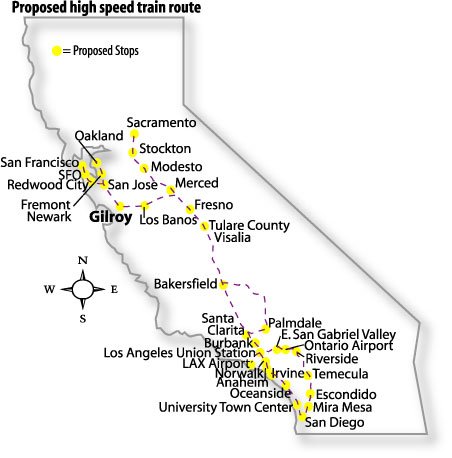GILROY
– Imagine a passenger train traveling 200 mph down Monterey
Highway, into Morgan Hill and east through Coe Park. Or, instead of
going east in Morgan Hill, the train continues whisking down
Monterey Road into Gilroy, where it turns east and climbs Pacheco
Pass.
GILROY – Imagine a passenger train traveling 200 mph down Monterey Highway, into Morgan Hill and east through Coe Park. Or, instead of going east in Morgan Hill, the train continues whisking down Monterey Road into Gilroy, where it turns east and climbs Pacheco Pass.
As the state continues to fine tune its environmental impact report for the proposed high-speed bullet train connecting the major cities in California, it’s clear that South County will serve as the rail’s route from the Bay Area to the Central Valley.
Of course, that’s if state voters approve a $9 billion bond for the proposed bullet train that will be on the November 2004 ballot.
If they do, and the $25 billion project gets final state legislature approval, trains traveling more than 200 mph will be zipping through South County’s Caltrain corridor and east to Merced via either Pacheco Pass or Henry W. Coe State Park as early as 2008, according to the most recent plans released by the California High Speed Rail Authority.
If Pacheco Pass is the chosen route for the rail, Gilroy will be one of the rail’s limited Bay Area stops. If the rail authority chooses the Coe Park route, the train will go through Morgan Hill but bypass Gilroy, according to Carrie Pourvahidi, the deputy director of the California High Speed Rail Authority based in Sacramento.
“It will be one of those two routes (Pacheco Pass or Coe Park),” Pourvahidi said. “Right now we are looking at the pros and cons of both, but it’s hard to say which one we’ll select in the end. Going through Coe Park would save travel time, but we would likely have to do some tunneling. But with the (Highway) 152 it seems there would be more municipalities to deal with.”
The environmental impact report from the High Speed Rail Authority is scheduled to be complete in August, but South County officials are already saying the rail would have a host of negative environmental impacts on the area.
Dennis Pinion, the director of Advocates for Coe Park, said his group will do all it can to make sure the proposed rail doesn’t go through California’s second largest state park.
“I can see them wanting to come through the park because it would be a lot more convenient to deal with the land rights with the state instead of private owners,” Pinion said. “But to have a 200 mph train coming through a protected state park is irresponsible and ridiculous, regardless of what their report may say.
“They told me it is a desirable route because its saves money,” he said, “but you can’t estimate what you would lose in the park because it can’t be replaced. We won’t let this happen.”
Other local officials such as Mayor Tom Springer have also voiced their opposition to the rail, which Pourvahidi said will build its South County tracks along existing Caltrain routes.
In an earlier interview Springer questioned the $25 billion price-tag for the project, and estimated it could balloon to as much as $50 billion.
But supporters of California’s 700-mile long rail got a boost last week from a proposed federal loan program for such projects. The powerful U.S. House Transportation Committee voted Wednesday to create a $60 million federal bond and loan program for high-speed rail projects like California’s.
If the bond is passed by Congress and the $9 billion state bond is passed by voters in November 2004, federal money could make up a sizable portion of the remaining $16 billion needed to build the rail, Pourvahidi said. Private investors are also expected to contribute to the rail.
“(The federal bond proposal) would certainly be something that could help us,” Pourvahidi said.
Linking the Bay Area, Central Valley, Sacramento, Los Angeles and San Diego, the high-speed rail would compete with airlines for passengers. Riding the rail, a trip between San Francisco and L.A. is expected to take less than three hours.
One-way fares for the rail have been proposed at around $25, but that could change quickly, Pourvahidi said.
“There is still a long way to go before we get certain aspects solidified,” said Pourvahidi, who expects to submit a final plan document for the rail to the public by December. “If the bond issue passes that will start everything, and we expect that the Caltrain corridor – because of its existing infrastructure – will be one of the state’s first area’s for construction.”
Rail proponents say the rail system concept – which has been successful in Japan and Europe – will help diversify and meet the state’s transportation needs as its population doubles over the next 40 years. They also say the rail line could help safeguard against future transportation disruptions such as those prompted by the Sept. 11 terrorist attacks.
Critics have expressed doubts the project is feasible and have argued the money would better be spent on more freeway projects.
Details: The High Speed Rail Authority’s next meeting will be on July 15 in Oakland. For more information go to www.cahighspeedrail.ca.gov.















